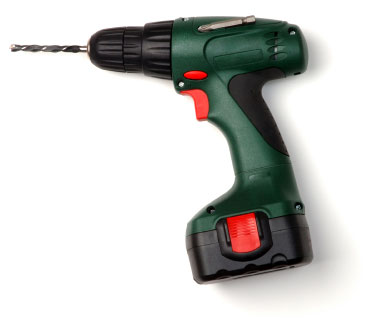
During the dawn of electrification at the end of the nineteenth century, electric tools had yet to be invented. Knob-and-tube wiring passed through wall plates (the horizontal 24s at the bottom of a wall) but ran along the surface of the wall studs, so electricians had little drilling to do. These days, it all passes through studs, plates, and joist, and no one in their right mind would hand-drill the necessary holes. The electric drill is probably the most ubiquitous power tool around. Drills are manufactured according to chuck size. The chuck holds the drill bit or another attachment such as a grinding wheel or a buffer pad. The larger the chuck, the bigger the drill motor (because more power is required to drive larger drill bits and attachments).
A manufacturer’s usual line of drills includes ¼-inch, 3/8-inch, and ½-inch models. Drills come in both corded and cordless models. A cordless model runs on a rechargeable battery. Cordless tools are really convenient. The drawback, of course, is battery life. The tougher the task, such as drilling through wood joist, the more demand on the battery and the shorter its work life before needing a charge. A high-end model such as a Makita ½-inch, 18-volt cordless will hold up longer under more demanding drilling, but it isn’t cheap (around $245). For repetitive, serious drilling, a corded model often is the best choice.
A cordless drill usually costs more than a corded model of equal size. Sales and closeouts can narrow the gap. Power is the key here, so stick to at least a 12-volt model. Also compare charging times for the batteries (the shorter the better).
A decent ½-inch drill will get you through most electrical drilling chores and just about any other job around the house. It will last for years and years doing occasional residential work without breaking your remodeling budget. Prices for an acceptable
½-inch electric drill start at around $70 and up. You’ll find a few other power tools and accessories to be useful as well including …
- A reciprocating saw for sawing large holes in walls and ceilings.
- A circular saw for framing work.
- 12/2 extension cords.
Extension cords are manufactured according to wire gauge, just like electrical cable. A 12/2 cord is made from 12-gauge wire and contains hot, neutral, and grounding conductors.

No comments:
Post a Comment